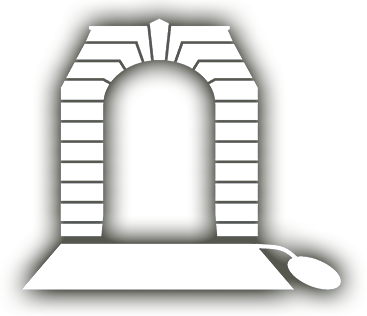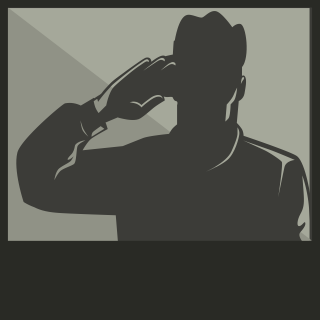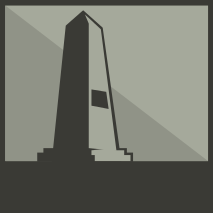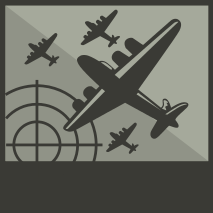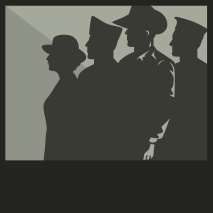Resources
Filter
Campaign
Air War Nw Europe 1939 45
(Clear)
Use quotes for more accurate searches - e.g., "2/10th infantry battalion"
Showing 6 of 6 results
-
463-squadron Lancaster 'S for Sugar' bombing-up at RAF Waddington. The large cylindrical bomb is an 8,000lb 'blockbuster' a larger version of the 4,000ln 'Cookie'.
-
Informal portrait of the crew of a Lancaster bomber of 467 Squadron RAAF prior to a night mission. Identified, left to right: 1352851 Sergeant (Sgt) Eric Reginald Hill, RAF, mid upper gunner of Weald, Essex; 423311 Flight Sergeant (Flt Sgt) Gilbert Firth Pate, RAAF, rear gunner of Belmore, NSW; 1350279 Sgt Kenneth Harold Tabor, RAF, flight engineer; 425413 Flt Sgt Alistair Dale Johnston, RAAF, wireless operator, of Melbourne, Vic; 400495 Squadron Leader (Sqn Ldr) Donald Philip Smeed Smith, DFC, RAAF, pilot of Melbourne, Vic; 412686 Warrant Officer Royston William Purcell, RAAF, navigator of Werris Creek NSW; 658844 Flt Sgt Jeremiah Parker, RAF, bomb aimer of England. The aircraft pictured is most likely the Lancaster Mark III bomber LM475 (PO-B). This was the usual aircraft flown by the crew listed above which crashed whilst on a mission over Lille, France, on 10 May 1944, of which only the pilot, Sqn Ldr Smith survived. Two weeks prior to this mission, bomber pilots were authorised to wear seat-type parachutes instead of the standard backpack that was stored in the plane and only hooked in case of need. This most likely saved Sqn Ldr Smith's life; on landing by parachute he made his way cross-country through France and Switzerland, and back to England several months later.
-
Squadron crews of mainly "C" Flight lined up in front of "A2" Aussie, March 1944.
-
A RAAF crew of a Lancaster Bomber from No 460 Squadron RAAF. Left to right: 408034 Flying Officer (FO) M. W. Carroll DFC of Ferntree Gully, Vic; Sergeant D. G. Champkin, RAF; 414807 Pilot Officer T. J. Lynch of Toowoomba, Qld (back); 404507 Squadron Leader E. G. D. Jarman DFC (Captain) of Yeppoon, Qld (centre front); 404467 Flying Officer (FO) H. R. Harrison of Lismore, NSW; 404503 FO F. G. Jackson DFC OF Lismore, NSW; 411227 FO R. L. Neal of Grenfell, NSW. This crew posed for a painting by war artist Stella Bowen. The crew was posted missing on 28 April 1944, and were later confirmed as lost in action. This and other photographs were used to complete the painting.
-
Out of the 596 aircraft on the raid 29 were shot down. These figure were fairly typical of RAF raids on German targets at the time – immense destruction was now almost assured at a cost that was, if not acceptable, then at least sustainable. Flight Engineer Sergeant C.H. ‘Chick’ Chandler was on one of the Lancasters that was not shot down that night. His experience was about as bad as it could get without becoming a casualty. In his memory the traumatic events remained to be replayed in slow motion: It was 0110 HOURS on the morning of 23 April 1944. We were a XV Squadron Lancaster III crew from Mildenhall on our 17th op and we were hit simultaneously by heavy flak and cannon fire from an Me 109 at the precise moment that our bombs were released on Dusseldorf. Being the flight engineer, I was standing on the right-hand side of the cockpit, as was usual during our bombing run, with my head in the blister to watch for any fighter attack that might occur from the starboard side. The bombs were actually dropping from the aircraft when there was a tremendous explosion. For a brief period of time everything seemed to happen in ultra-slow motion. The explosion knocked me on my back; I was aware of falling on to the floor of the aircraft, but it seemed an age before I actually made contact. I distinctly remember ‘bouncing’. Probably lots of flying clothing and Mae Wests broke my fall, but under normal circumstances one would not have been aware of ‘bouncing’. As I fell I ‘saw’, in my mind’s eye, very clearly indeed, a telegram boy cycling to my mother’s back door. He was whistling very cheerfully and handed her the telegram that informed her of my death. She was very calm and thanked the boy for delivering the message. As I laid there I saw a stream of sparks pass a few feet above the cockpit, from back to front and going up at a slight angle. This caused me some confusion. If the sparks were from a burning engine they were going the wrong way. It was some little time before I realised that the ‘sparks’ were in fact tracer shells from a fighter that I did not know was attacking us. The illusion that the tracer shells were going upwards was no doubt caused by the fact that our Lancaster was going into an uncontrolled, screaming dive, but because of the slow-motion effect that I was experiencing, I did not appreciate this fact. This whole episode had taken 2 or 3 seconds at most, then the slow-motion effect began to wear off, and I became aware of the screams of the bomb-aimer. [after the aircraft went through violent evasive dives they threw off the fighter … the order to prepare to ‘bale out’ was withdrawn after they discovered that most of the parachutes had been destroyed] My task now was to check the aircraft for damage and casualties. My checks started at the front of the aircraft, in the bomb-aimer’s compartment. I am afraid to say that my sheltered life had not prepared me for the terrible sight that met my eyes. It was obvious that this area had caught the full blast of the flak, and Alan Gerrard had suffered the most appalling injuries. At least he would have died almost instantaneously. Suffice to say that I was sick. At this stage I risked using my torch to shine along the bomb bay to make sure that all our bombs were gone. My report simply was that the bomb-aimer had been killed and that all bombs had left the aircraft. Next stop was the cockpit. The pilot had really worked wonders in controlling the aircraft and successfully feathering the engine that had been on fire. Then on to the navigator’s department; on peering round the blackout screen I saw that Ken Pincott was busy working over his charts, but that Flight Lieutenant John Fabian DFC, the H2S operator (the Squadron navigation leader), appeared to be in shock. However, once I established that there appeared to be no serious damage, I moved on. The wireless operator’s position was empty because his task during the bombing run was to go to the rear of the aircraft and ensure that the photo flash left at the same time as the bombs. Next, down to the mid-upper turret, where Ron Wilson had re-occupied his position, albeit only temporarily. (Unknown to me, he had suffered a wound to his ear that, although not too serious, would keep him off flying for a few weeks.) On reaching the next checkpoint I was again totally unprepared for the dreadful sight that confronted me. Our wireless operator, Flight Sergeant L. Barnes, had sustained, in my opinion, fatal chest injuries and had mercifully lost consciousness. It was found later that he had further very serious injuries to his lower body and legs. He died of his wounds before we reached England. From the rear turret I got a ‘thumbs up’ sign from ‘Whacker’ Mair, so I rightly concluded that he was OK. As well as having to report the death of our bomb-aimer, and the fatal injuries to the wireless operator, I had to report the complete failure of the hydraulic system. The pilot was already aware of the fact that we had lost our port inner engine through fire, and that our starboard outer was giving only partial power. The bomb doors were stuck in the open position, and the gun turrets had been rendered inoperative because of the hydraulic failure. Post script: They had just enough fuel to make it back to England, gradually losing height all the way, only to discover that their undercarriage was stuck as they came in to land. The remaining crew survived the emergency landing. All the survivors remained on flying duties, only the slightly wounded mid upper gunner had a brief respite. See Bowman (Ed.) RAF Bomber Stories: Dramatic First-hand Accounts of British and Commonwealth Airmen in World War 2
-
Lille is a major rail hub in northern France close to the Belgian border and a major junction between Paris, to the south, Calais to the west and Brussels (Belgium) to the north. It was a key target in the run up to D Day in June 1944 when a major bombing offensive called the Transportation Plan, was directed at transport infrastructure, to impede the provision of reinforcements to the intended battlefront - the location of which was, of course, top secret at this point in time. On the night of 10/11 May 1944 a large fleet of bombers were despatched to bomb a series of rail yards in northern France, at Lille, Lens (further south), Courtrai, Ghent (further north in Belgium) and Dieppe on the Atlantic coast. Over 500 aircraft were involved; the majority were Lancasters but also Halifaxes and some fast and nimble Mosquitos performing a Pathfinder and Target marking role. Both 463 and 467 Squadrons RAAF were scheduled to take part in the Lille raid on the evening of 10/11 May. It was to be the worst night of the war for the two Waddington squadrons. Of 31 aircraft despatched between them, six failed to return. The total losses of the raid were 12 so the two RAAF squadrons represented 50% of the total losses. A total of 42 men were missing the next morning. This represented a loss rate of 20%. The impact of the empty seats at breakfast would have been devastating. This was followed the next night by the loss of 467 Squadron's CO, decorated Pacific veteran GPCAPT John 'Sam' Balmer OBE DFC and his crew, leading another Transportation Plan raid. There was only one survivor from the six Australian aircraft. Squadron Leader Phil Smith, DFC, flying B for Baker in 467 Squadron was thrown clear of his exploding aircraft, and managed to parachute to safety minus a flying boot and then spent four months evading the Germans. B for Baker exploded as it was dropping its bombs; it may have suffered a similar fate to JO-J in 463 Squadron - been destroyed by a German night fighter attacking from below (but unlikely given they were directly over the target where the risk from flak and falling bombs tended to discourage night fighter attack), been hit by flak or most likely, it may have collided with another aircraft The story of JO-J's loss from 463 Squadron, provides an insight as to the fate that befell a number of aircraft that night and the cause of losses that was only identified the following month when a German nightfighter fitted with upward firing cannon, was captured after it landed at an occupied airfield by mistake. JOJ was shot down on its way home, by Lt Hans Schmitz flying a Messerschmitt Bf110G night fighter variant with upward firing cannon, nick-named 'Schrage Musik' by the Germans. The aircraft positioned itself in a blind spot under the Lancaster, before unleashing a hail of 20mm cannon fire into the underside of the bigger plane. The effect was often catastrophic as was the case with JOJ, which broke up in mid-air and rained wreckage in and around the Dumoulin quarry near Langemark in northern Belgium. There were no survivors. LL881 - 22/03/44 to 10/05/44, Callsign JO-E: 11 Missions. The first on 22/23-Mar-1944 to Frankfurt. The 9th mission on 10/11-May-1944 to Lille when LL881 was listed as missing. 418915 FSGT John Henry BROWN RAAF WOP 31 HELLEMMES 427445 FSGT George Martin DANN RAAF RGNR 30 FOREST/MARQUE 430019 FSGT Colin Henry EASTGATE RAAF MUG 29 FOREST/MARQUE 410493 FLGOFF George Oswald JONES RAAF NAV 23 FOREST/MARQUE 10119 POFFR William John LEWIS RAAF FENG 32 FOREST/MARQUE 416443 WOFF Alan Richard MacKENZIE RAAF BAim 26 FOREST/MARQUE 420413 FLGOFF Dudley Francis WARD RAAF PILOT 24 FOREST/MARQUE 8 missions were flown by this crew. LL-882 - 463 Sqn. 24/03/44 to 10/05/44, Callsign JO-J 'The Langemark Lancaster - see related story. There were 15 missions recorded in the Operational Record with the first in March 25/26 1944 to Aulnoye. 407199 FLOFF Robert McKerlie CROFT RAAF MUG 27 WEVELGUM 407821 FLOFF David Payne CROSTON RAAF RGNR 32 WEVELGUM 1443752 FSGT Bertram FRASER RAF BAim 22 WEVELGUM 134697 FLOFF Ronald JACQUES RAF NAV ? WEVELGUM 1802369 SGT Harry Law MOLYNEUX RAF FENG 21 WEVELGUM 422817 SQNLDR Mervyn POWELL RAAF PILOT 29 WEVELGUM 406700 FLTLT William Neil READ RAAF WOP 22 WEVELGUM HK535 - 463 Sqn. 20/12/43 to 10/05/44, Callsign JO-N 11 Missions. First mission to Frankfurt 20/21-Dec-1943. This was their 11th Mission 24519 FSGT Richard William ASH RAAF MUG 20 HELLEMMES 1609134 SGT Raymond Herbert BOULTON RAF FENG 19 HELLEMMES 422414 FSGT Ivan CHAPPLE RAAF NAV 24 HELLEMMES 423878 POFF Walter Thomas PETERS RAAF BAim 24 HELLEMMES 1459044 SGT Leonard Edgard PRINGLE RAF WOP ? HELLEMMES 425226 FLTLT Eric Mc Laren SCOTT RAAF PILOT 22 FOREST/MARQUE 424888 WO William Allen SLADE RAF RGNR 23 MISSING No. 467 Squadron RAAF LM475 Callsign PO-B for 'Baker'. A very experienced crew. First mission Dec 1943 See blog link in Sidebar. This was their 20th Mission and the last for Phil Smith to complete his second Tour. 1352851 SGT Eric Reginald HILL RAF MUG 22 LEZENNES 425413 FSGT Alistair Dale JOHNSTON RAAF WOP 24 LEZENNES 658844 FSGT Jeremiah PARKER RAF BAim 30 LEZENNES 423311 FSGT Gilbert Firth PATE RAAF RGNR 27 LEZENNES 412686 WOFF Royston William PURCELL RAAF NAV 22 LEZENNES 400495 SQNLDR Donald Phillip Smeed SMITH RAAF PILOT EVADE the only survivor from 12 aircraft 1850279 SGT Kenneth Harold TABOR RAF FENG LEZENNES LL788 Callsign PO-G 2221020 SGT Charles Arthur NASH RAF MUG 23 FOREST/MARQUE 424914 FSGT Herbert William Reid FERGUSON RAAF RGNR 28 HELLEMMES 417176 FSGT Brian Gordon GRASBY RAAF WOP 21 HELLEMMES 422506 FSGT William Stanley HANCOCK RAAF BAim 22 HELLEMMES 1431527 SGT Cyril DUTHOIT RAF FENG LEZENNES 420870 POFF William Eldred FELSTEAD RAAF PILOT 22 LEZENNES 1580333 SGT John MELLOR RAF NAV 30 LEZENNES EE143 Callsign PO-J 427870 FSGT Bernard Francis CODY RAAF MUG 23 ANNAPPES 2220133 SGT George BENNETT RAF RGNR 27 HELLEMMES 419298 FLOFF Harry Ronald CROUT RAAF BAim 29 HELLEMMES 414997 POFF Douglas HISLOP RAAF PILOT 23 HELLEMMES 1891298 SGT Bertram Stephen LONGHURST RAF FENG 37 HELLEMMES 25243 FLOFF John Francis TUCKER RAAF WOP 25 HELLEMMES 424239 FSGT Kevin Campbell WAIGHT RAAF NAV 20 HELLEMMES Three other Australians were lost in other aircraft on the raid; 414761 POFF Hugh DonaldD CAMPBELL RAAF PILOT 23 9 Sqn LM528 WS-D HELLEMMES 423359 FLOFF Albert Edward TYNE RAAF BAim 33 9 Sqn LM528 WS-D FOREST/MARQUE 425794 FSGT Walter James WHITE RAAF AG 23 9 Sqn LM520 WS-X FOREST/MARQUE This remains a work in progress We are tracking images of these men; if you can help, Register and join over 20,000 people who have contributed material to the site. Thanks to ADF Serials website for this detail, and to the researchers of 'Aircrew Remembered' to which links have been posted. Thanks also to Conrad Dumoulin, Belgium for providing assistance in the preparation of this article and that of the 'Langemark Lancaster' to which his father was a witness. Thanks to Adam Purcell, his excellent blog @somethingverybig.com and the story of 'B for Baker' of No. 467 Squadron CWGC websites and cemetery pages WW2 Nominal Roll AWM Roll of Honour
Page 1 of 1
This page is supported by a grant from the ANZAC Day Commemoration Council

